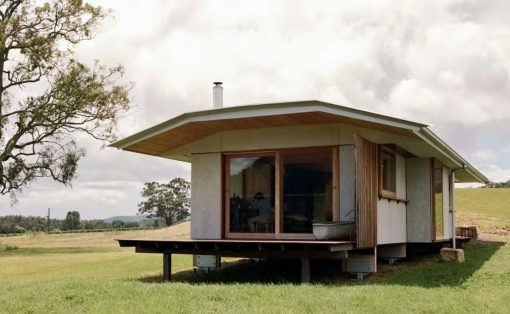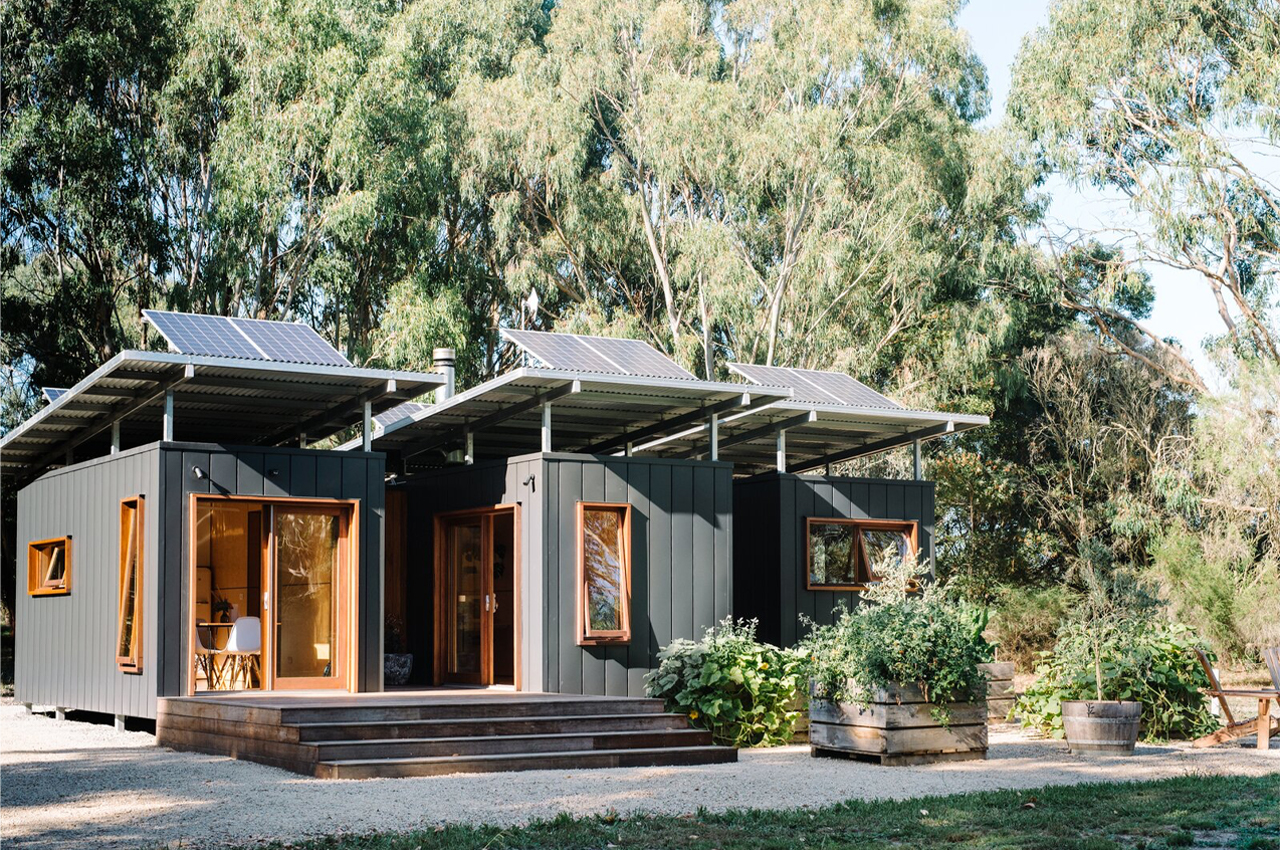
2022 has brought with it some exciting new tiny home designs! Sustainability has been running on everybody’s mind. Ever since the pandemic shook up our world, we’re trying to incorporate sustainability into every aspect of our life, including our homes! And, with everyone aspiring toward’s eco-friendly and mindful ways of living, tiny homes have completely taken over the world of architecture and cemented their place as sustainable, minimal, and economical micro-living setups. What started off as a cute little trend is now turning into a serious option for home spaces. They are a space-saving and eco-friendly living solution that reduces the load on Mother Earth! They’re simple and minimal alternatives to the imposing and materialistic homes that seem to have taken over. And, we’ve curated a wide range of micro-home setups that totally grabbed our attention! From an AI-enabled prefab tiny home to a tiny home built from three shipping containers – there’s a tiny home out there for everyone!
1. Wattle Bank home
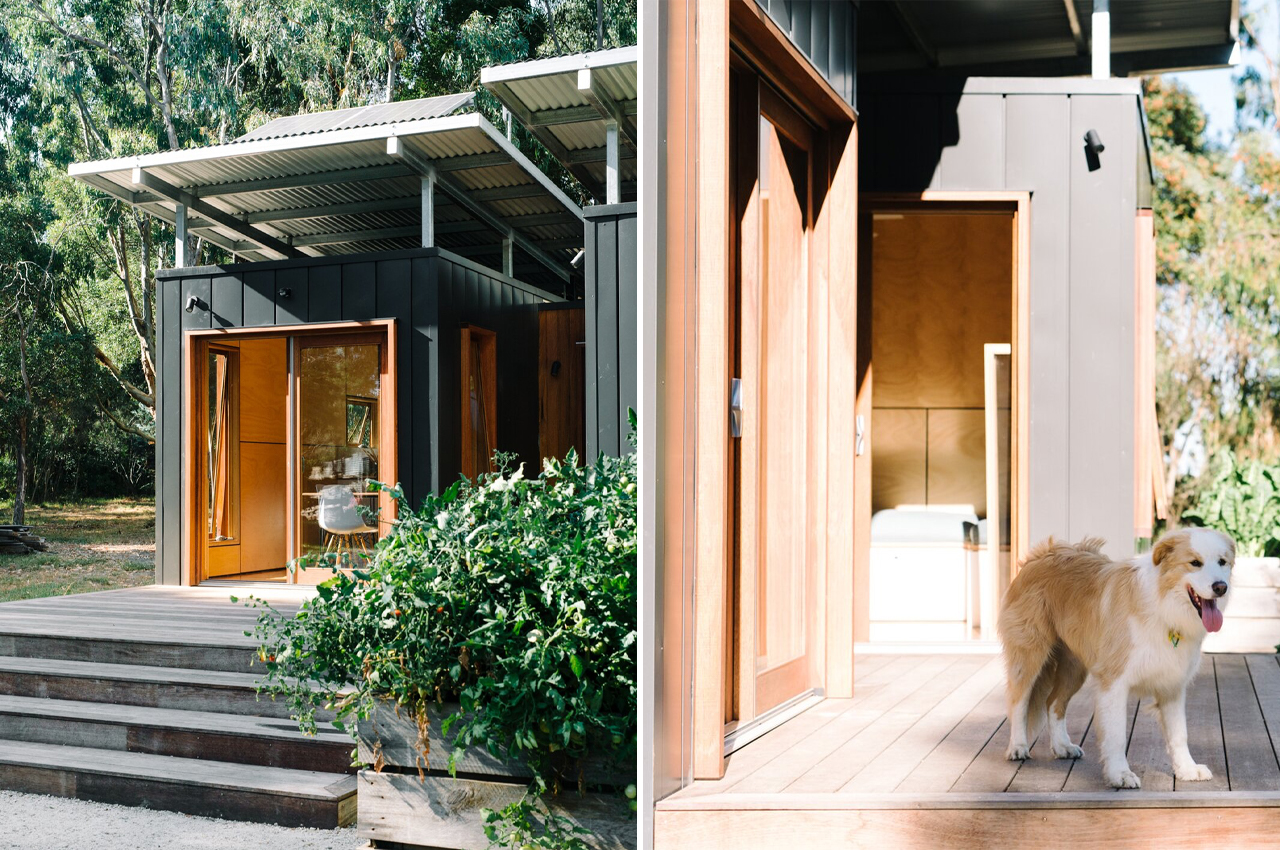
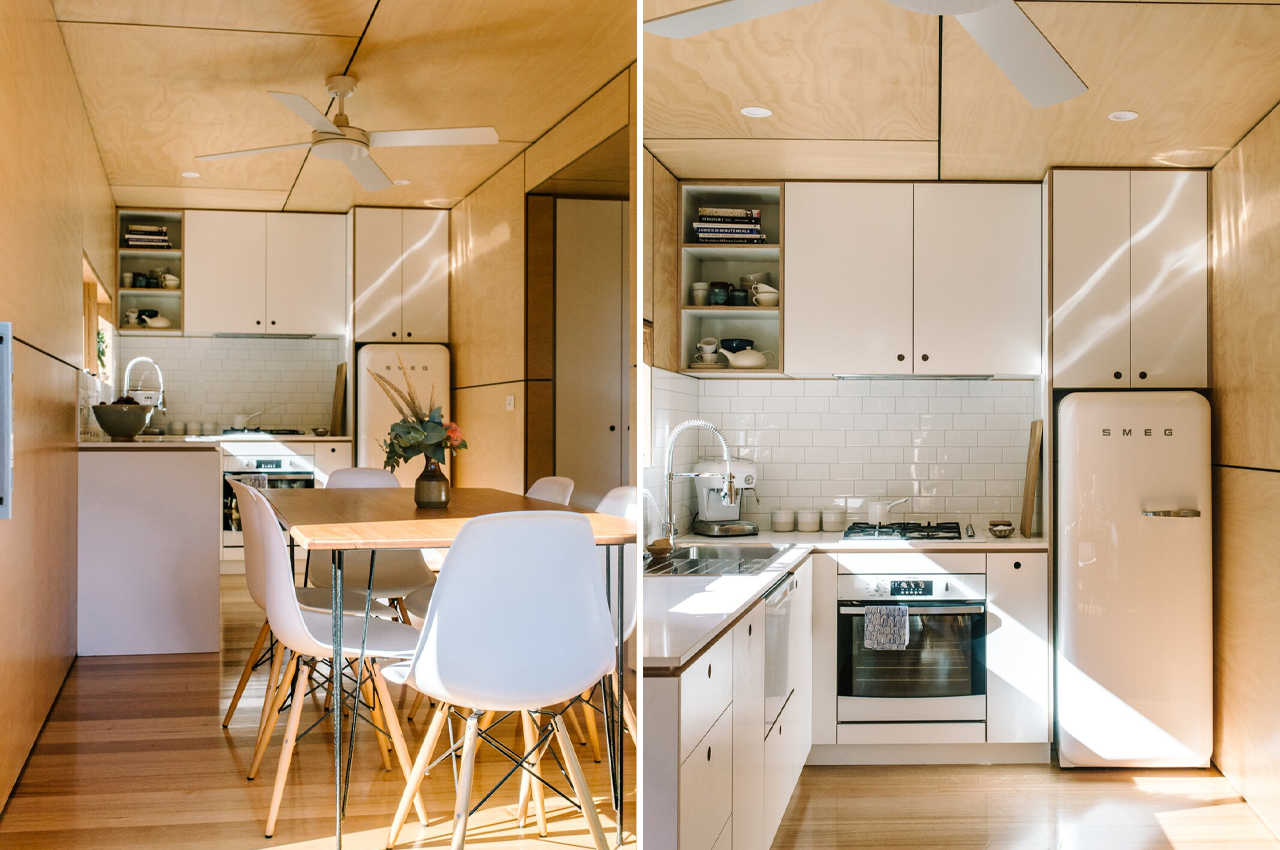
Situated on a plot of land on Amy’s parents’ farm, the couple’s Wattle Bank home was designed and built by the modular home building company, Modhouse, founded by Amy’s parents Mark and Melissa Plank. Each 20-foot shipping container that comprises the tiny home connects to one another via integrated passageways. These hallways also help make the most of the available living space by hosting utility rooms, like the laundry and entryways. Throughout the home, floor-to-ceiling entryways and windows give the feeling of indoor-outdoor living, adding some extra space to the interior as well.
Why is it noteworthy?
While downsizing our lifestyle requires letting go of many luxury comforts, it also makes room for simpler life pleasures. Sure, getting rid of the pool might hurt a little, but more green space allows for more plant cultivation and harvesting. For one Australian couple, Amy Plank and Richard Vaughan, downsizing meant disbanding from domestic duties for the freedom to surf, garden, and enjoy nature whenever and however they like. Hoping to make their dream of a downsized, sustainable lifestyle a new reality, Plank and Vaughan found the freedom they hoped for in shipping container architecture. Merging three shipping containers together to form a 530-square-foot tiny home, Plank’s and Vaughan’s Wattle Bank home fits the bill.
What we like
- Provides a feeling of indoor-outdoor living
- Built using eco-friendly materials
What we dislike
- Not much to distinguish it from other shipping container-based architecture out there
2. Hewing Haus
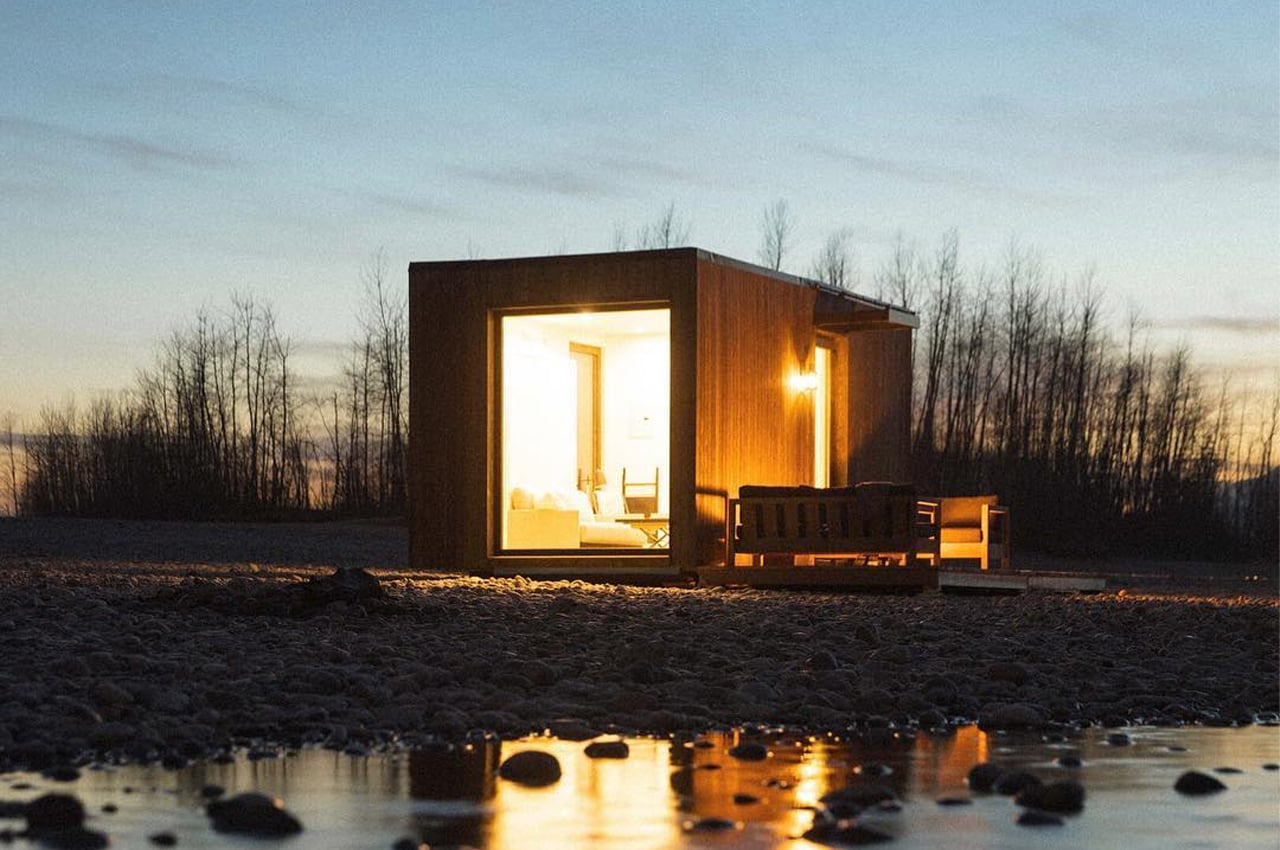
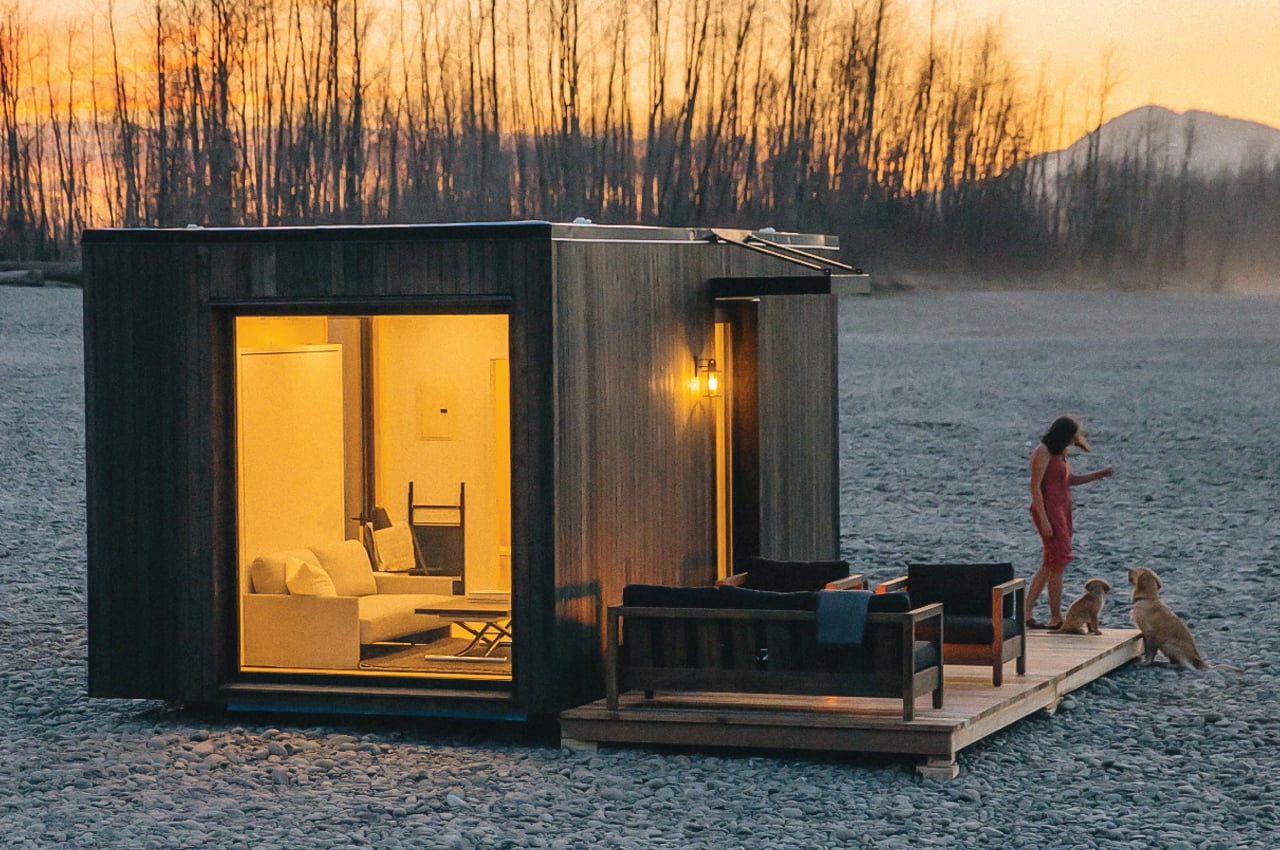
Four basic units comprise Hewing Haus’ prefabricated tiny home catalog, ranging in size from 200sqf to 600sqf. Expanding on their commitment to sustainability, Hewing Haus constructs their tiny homes from cross-laminated timber (CLT), large-scale, prefabricated, solid engineered wood panels that “sequesters carbon making constructions fast, quiet and less costly,” as Hewing Haus builders describe.
Why is it noteworthy?
Hewing Haus is a prefabricated tiny home company that uses clean construction to build small-footprint tiny homes from sustainable materials. Responding to the demand for additional residences across global cities, the tiny home builders with Hewing Haus “leverage clean construction to build beautiful, small-footprint dwellings with the world’s strongest and most sustainable materials.”
What we like
- Carefully planned out to optimize floor space and maximize living
- Built using sustainable materials
What we dislike
No complaints!
3. Topol-27
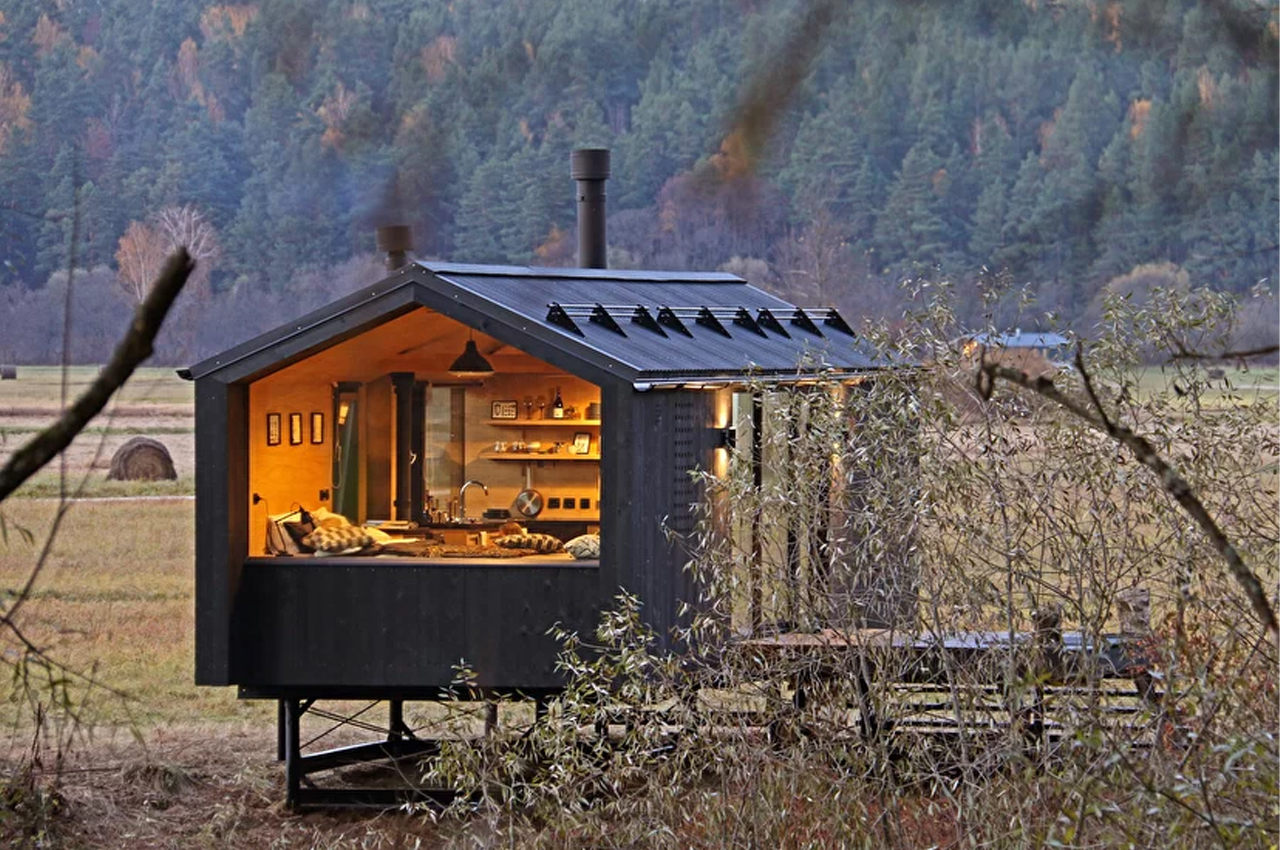
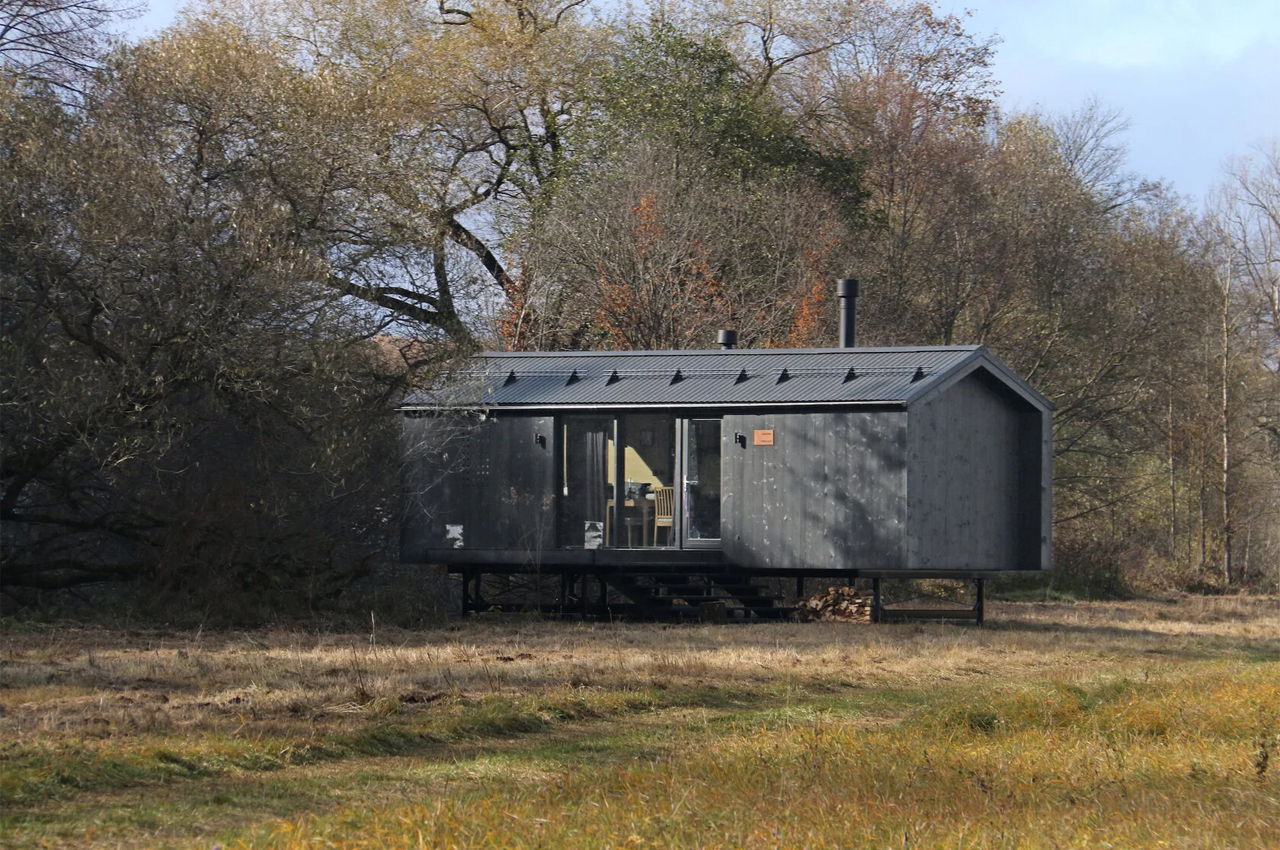
Built entirely offsite, Bio Architect’s prefabricated construction process cut down on the energy otherwise required for the shipping and handling of building material. Once transported to its final location, the home was positioned atop an aboveground metal frame that gives the home a lofty appeal. Walking through the front door, the home’s residents are greeted by the kitchen and dining area that merges seamlessly with the single sleeping space. Then, on the other end of the home, a bathroom and dressing room host all of the amenities needed for comfortable living.
Why is it noteworthy?
Joining the tiny house movement, Moscow-based Bio Architects has finished work on Topol-27, a prefabricated, modular tiny home designed to “be picked up from the warehouse by the client, installed the same day, and be ready to live.” Comprised of five functional areas, Topol-27 is named after the square meterage it covers. With the aim of maximizing the available living space, Bio Architects fills Topol-27 out with a bedroom, kitchen, living room, bathroom, and dressing room.
What we like
- Built entirely offsite
- Built from environmentally friendly and durable materials
What we dislike
- The black metal overcoat gives the tiny home a bit of an obscure profile from the outside
4. Adraga
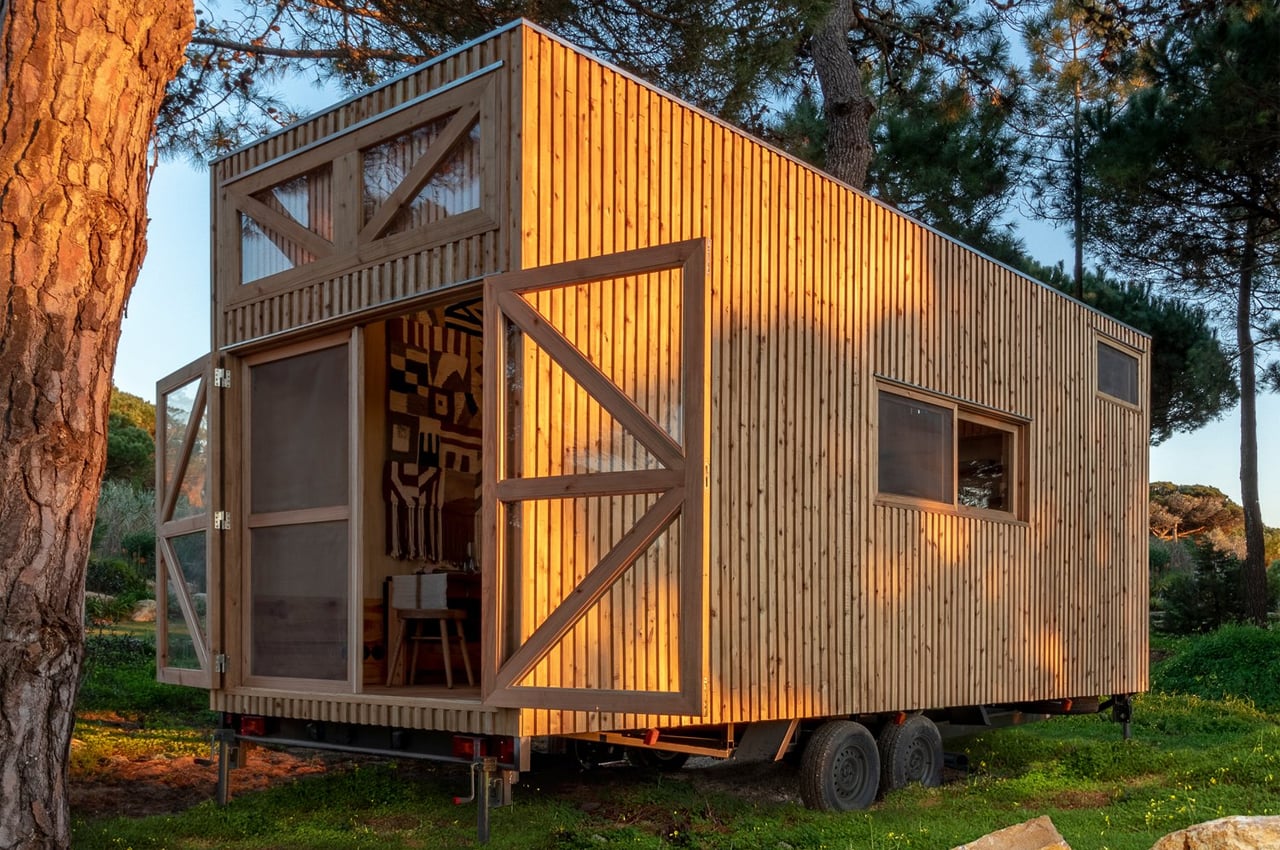
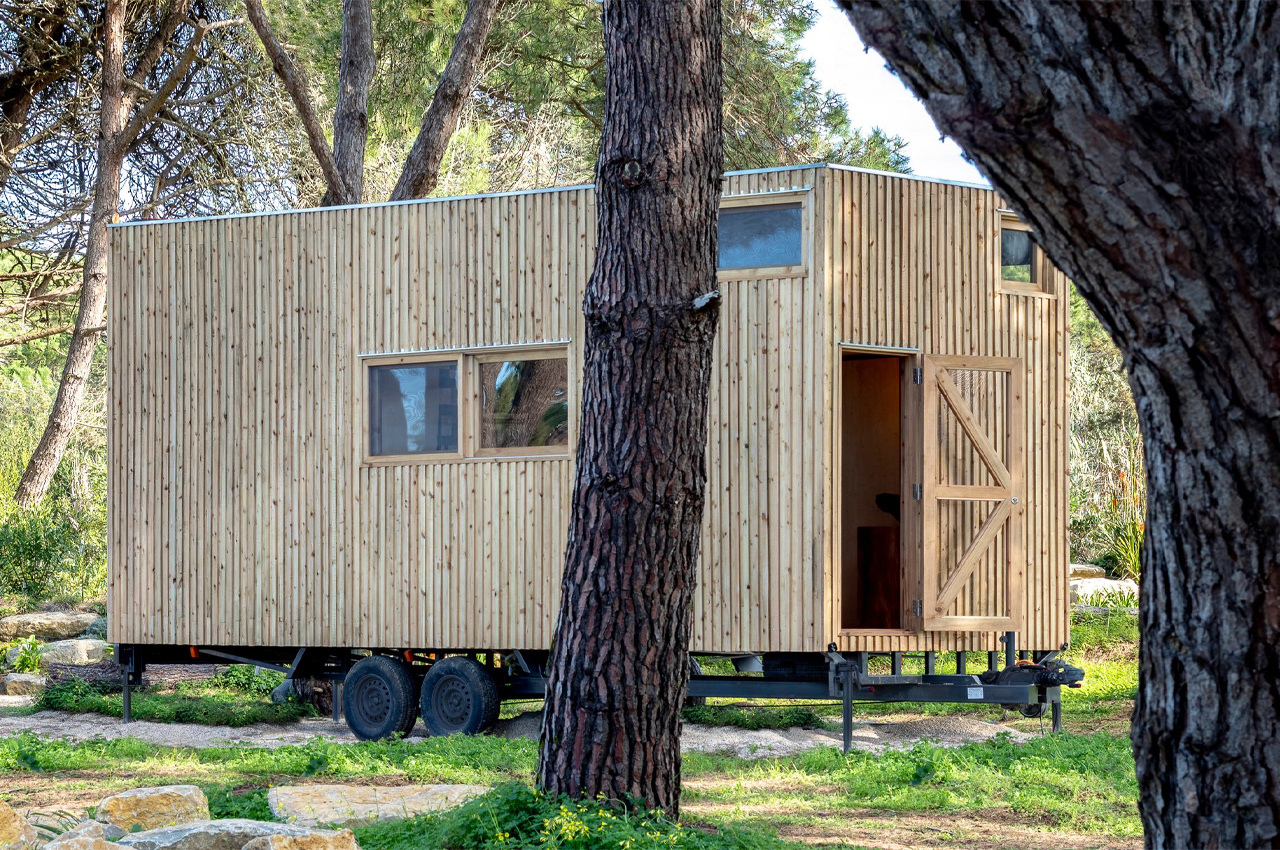
Called Adraga, the tiny home features an array of sustainability elements including solar panels, rainwater collection, and composting garden beds. As part of a larger series of tiny home one wheels, Adraga is home to a retired couple who just want to disconnect from the busyness of the world.
Why is it noteworthy?
Looking at Adraga from the outside, its unstained pinewood facades invoke simplicity. Defined by a rectangular, flat-roofed silhouette, the team at Madeiguincho found movement through windows and doors. On one end of the tiny home, a single, farmhouse-style door welcomes residents into the home’s subdued bathroom. There, against the soothing backdrop of walnut wood panels, residents can enjoy a semi-outdoor shower atop wooden floor slats.
What we like
- The layout of Adraga is designed to optimize the available floor space
- Incorporated with various off-grid elements
What we dislike
- In the bathroom, a dry toilet operates without flush water and closes the waste loop – but not everyone may be comfortable with using it
5. The Mansfield Container House
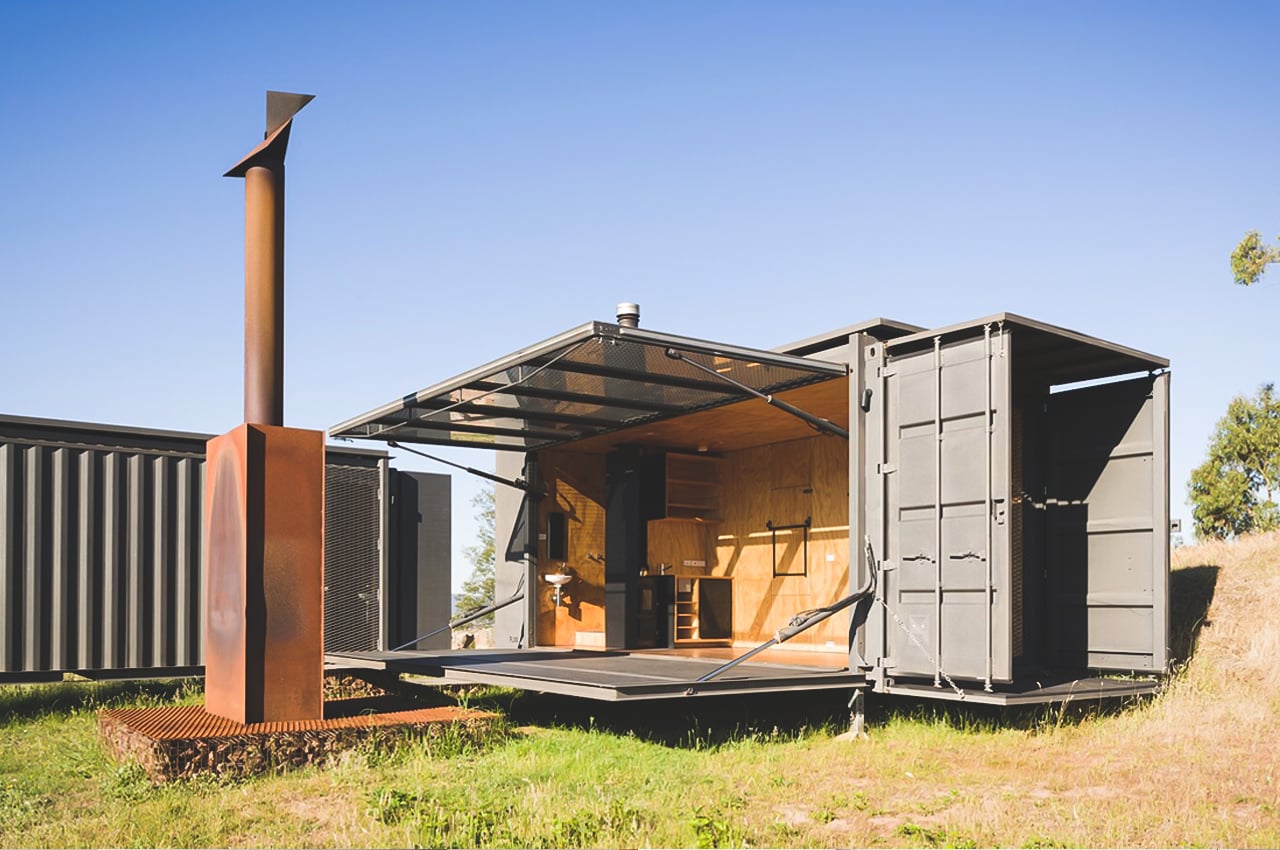
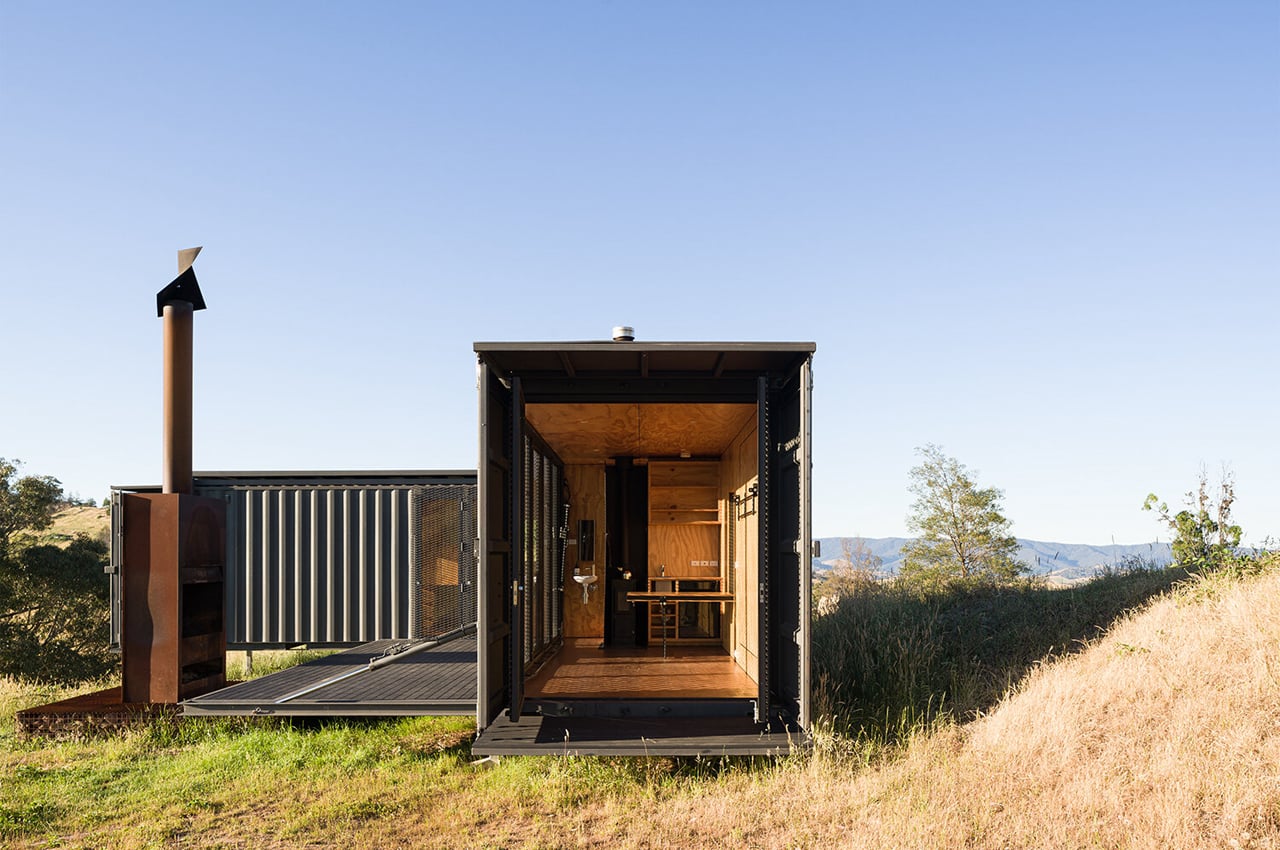
Named Mansfield Container House after the town where it resides, Walker’s tiny home is comprised of two 20-foot shipping containers that amount to 30-square-feet in total. Coated with heavy-duty paint, Walker hoped to maintain the industrial personality of shipping containers on the outside. Inside, natural, polished plywood clads the interior walls to help brighten the exterior’s heavy-duty look.
Why is it noteworthy?
The Mansfield Container House is an L-shaped tiny home composed of two disused shipping containers that merge together to form a tiny, off-grid cabin. Shipping container homes have redefined modern architecture. Designers and architects across the globe have turned to disused shipping containers to convert into insulated, tiny homes. Cost-effective, eco-friendly, and modular by design, shipping containers provide the ideal template for designers and architects to have at it and let their creativity fly.
What we like
- Solar panels were placed on the roof to generate and store solar power
- Water bladders were built into the roof to preserve 1,000 liters of rainwater
What we dislike
- Not much to distinguish it from other shipping container-based architecture out there
6. Moliving
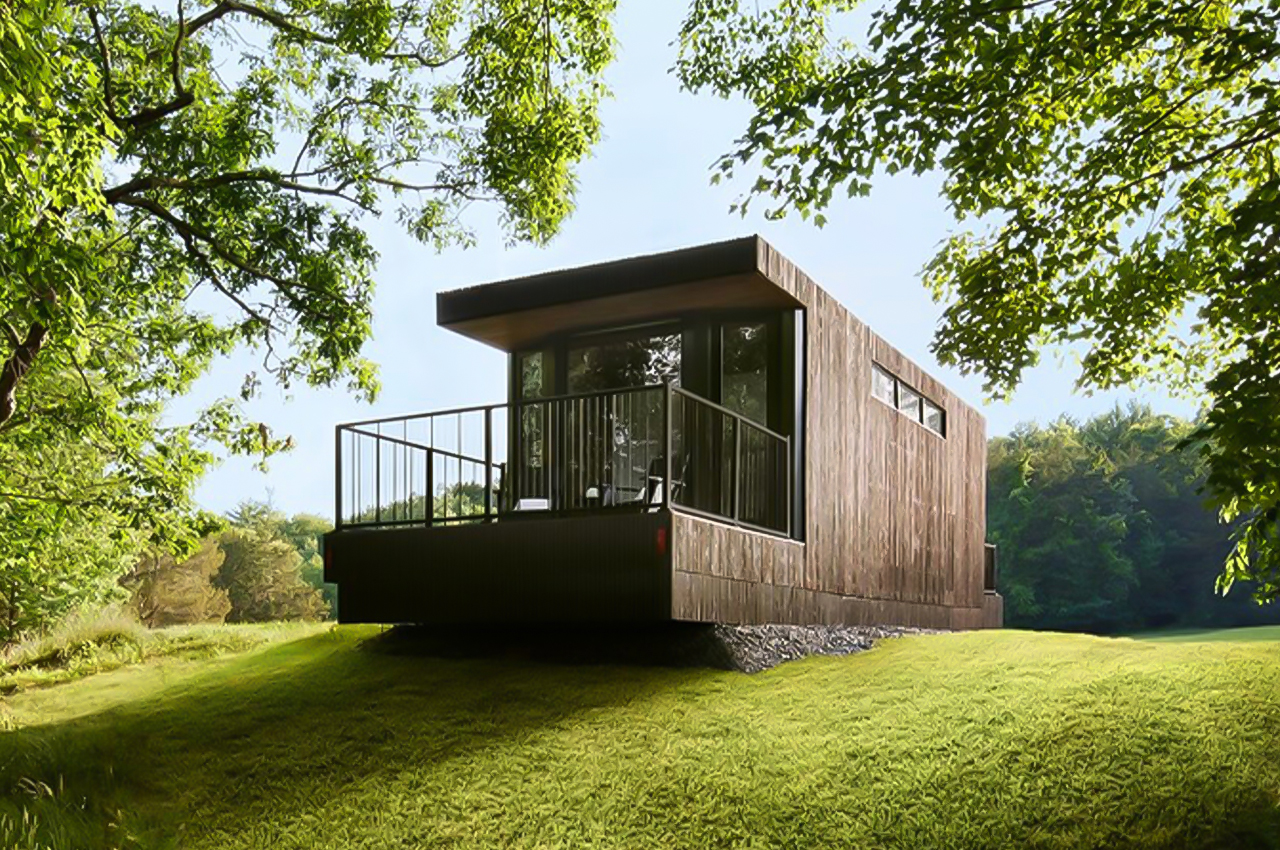
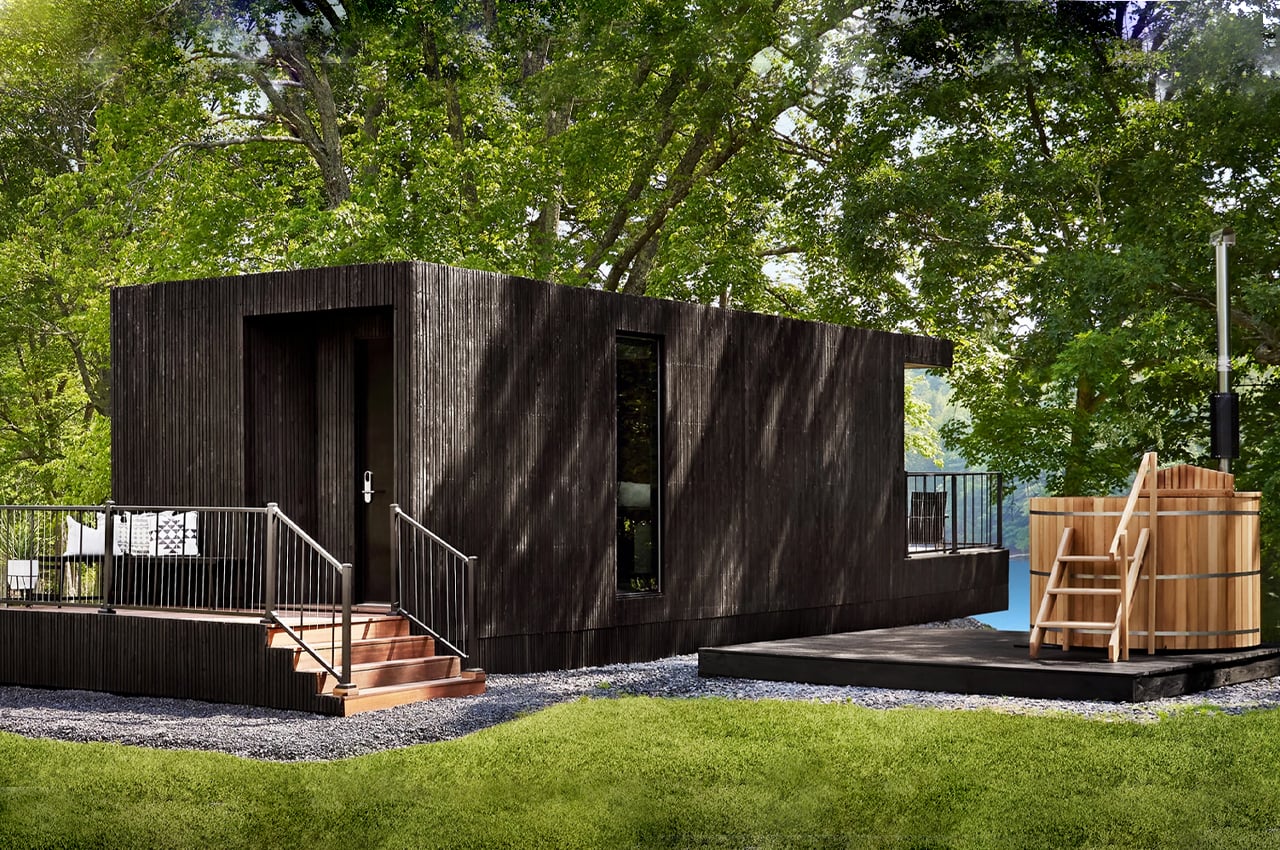
Moliving is a nomadic hospitality solution made up of Scandinavian-inspired prefab tiny homes. Compared to the years that it takes to give rise to traditional hotel accommodations, Moliving boasts a 3-5 month construction, assembly, and installation process. Built with Green- Steel, proximity woods, and other sustainable materials, Moliving’s Hurley House units have a sustainable construction process as well.
Why is it noteworthy?
Moliving, a nomadic hospitality solution, has developed a line of Scandinavian-inspired, prefabricated tiny homes called Hurley House, which can be placed anywhere as tiny private retreats for guests to find relaxation. With hopes of providing city dwellers with a private, countryside oasis, Hurley House is set to replace Hudson Valley’s now-inoperative Twin Lakes Resort.
What we like
- Short construction + installation duration
- Built from sustainable materials
What we dislike
- The classic hotel suite-inspired interiors are unexciting
7. Riverside Cabin
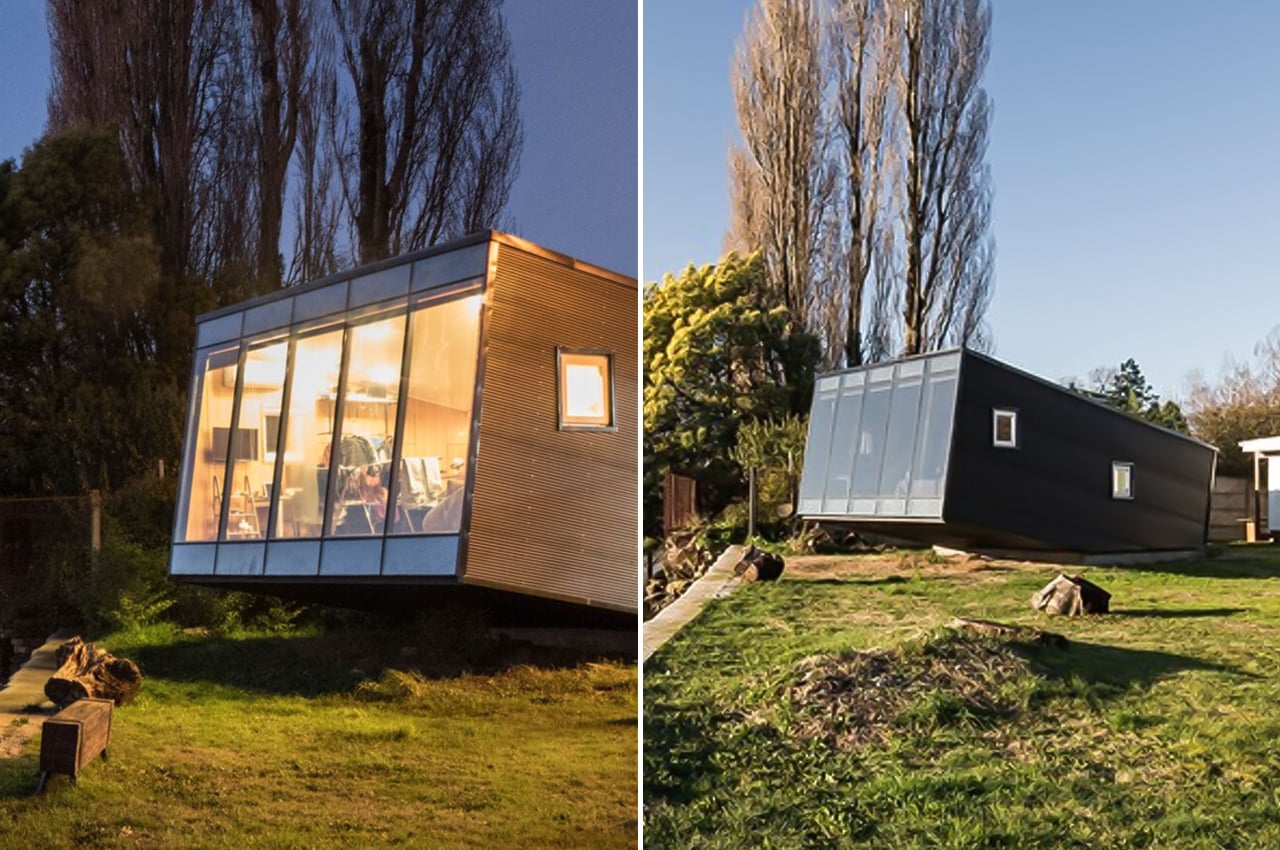
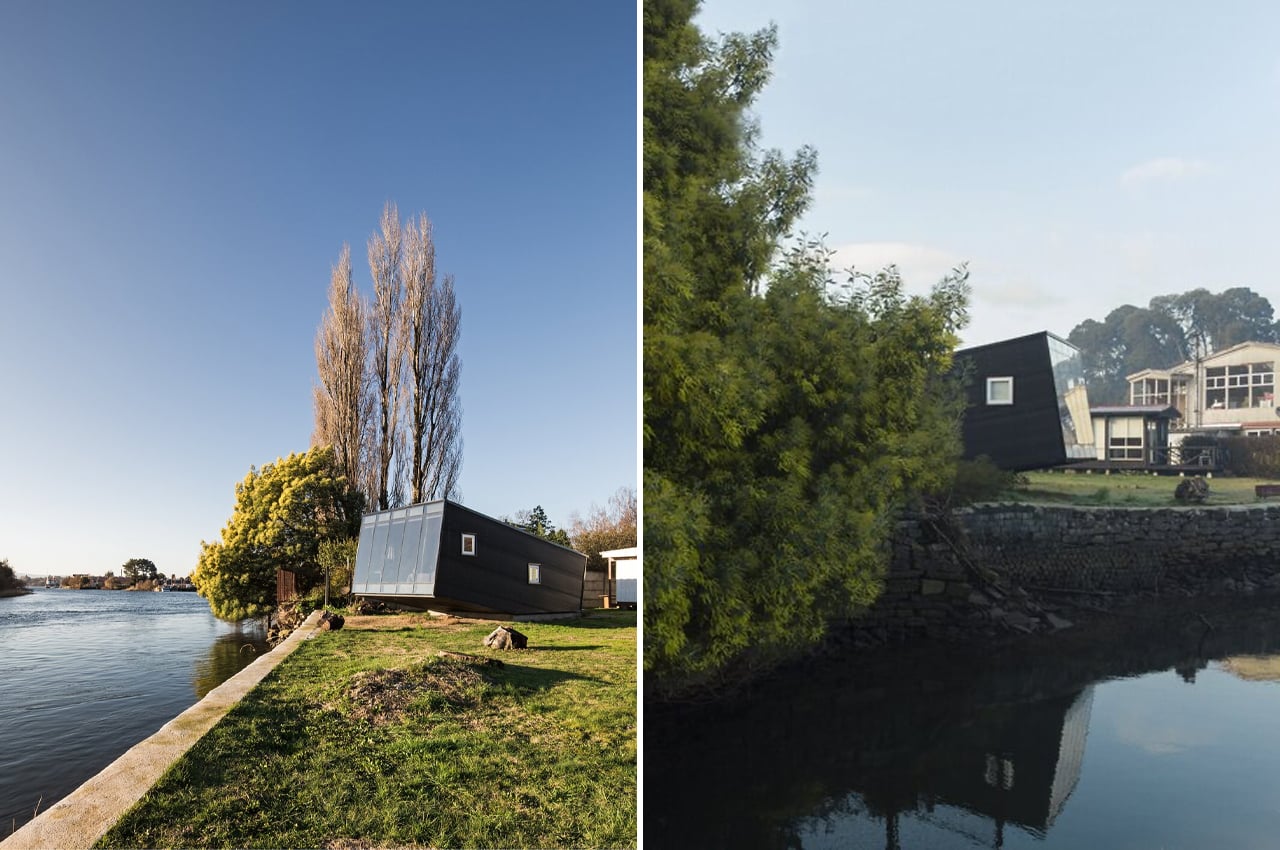
On the banks of the Calle-Calle River in Valdivia, Región de Los Ríos, architects with Arce & Westermeier were commissioned to design and construct a shelter to function as a local professor’s riverside retreat. Located close to the Universidad Austral de Chile, the tiny home is called Riverside Cabin after its harmonic relationship with the Calle-Calle River. Brimming from the natural treeline that extends along the river’s edge, Riverside Cabin takes on an unconventional shape that embraces the home’s surrounding landscape and ecosystems.
Why is it noteworthy?
In the initial stages of designing Riverside Cabin, the architects with Arce & Westermeier asked, “What kind of relationship with the river do we want: a traditional one, which seeks that each program enclosure manages to please itself with this unique geographical element? Or rather, one that selects where and how this visual pleasure is obtained?” Upon realizing they’d like to explore the latter, Arce & Westermeier found Riverside Cabin’s unique look. Tilting one end of the cabin towards the sky elongated the internal volume and gave the ceiling lofty heights to accommodate the bi-level interior.
What we like
- Blends in with the surrounding architecture, without taking away from the available views of the river
- Built using prefabricated metal plates that brace Chile’s rainy climate
What we dislike
- Not everyone may find the home’s unique shape and tilt appealing
8. Cube One

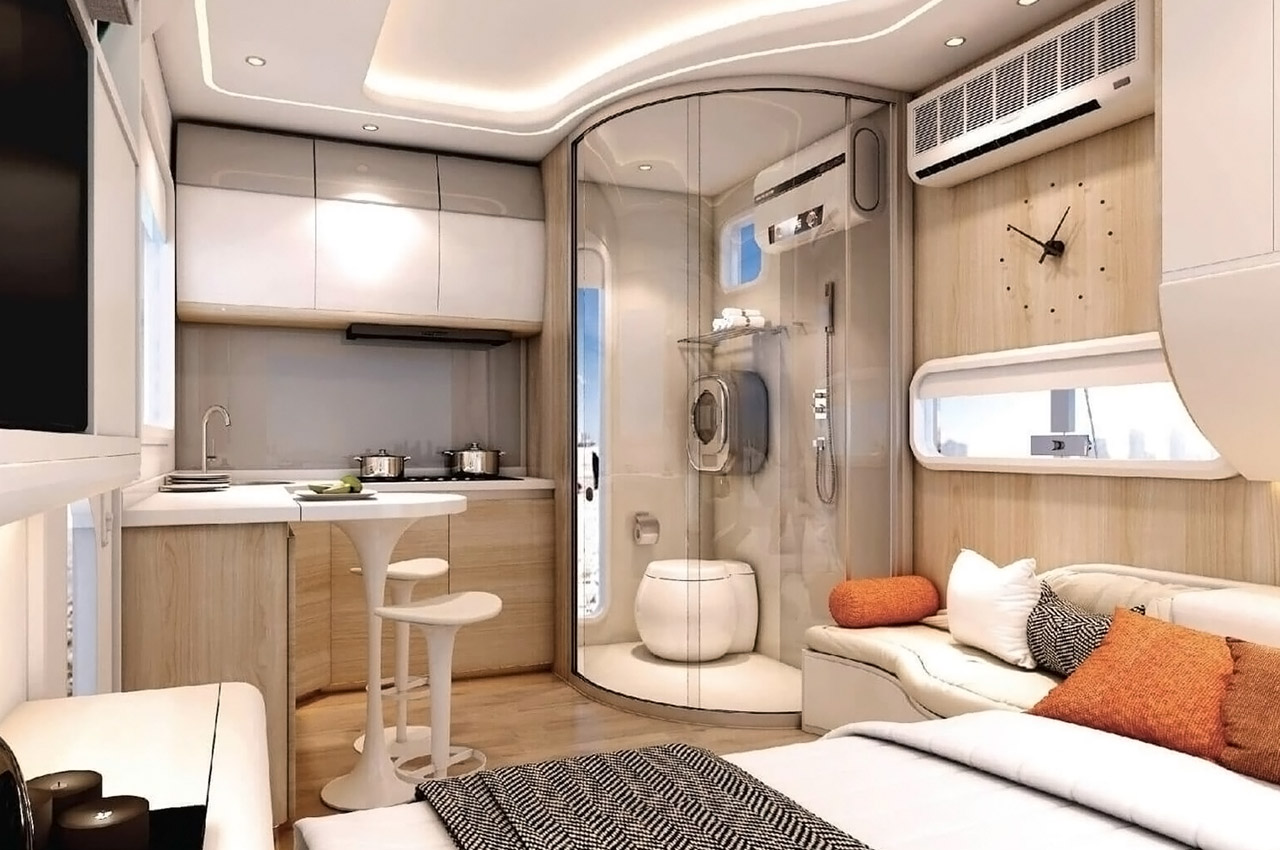
Low-cost, prefabricated, and ready to live in homes are all the rage right now! And tiny home builder Nestron has jumped on the bandwagon with their latest AI-enabled home ‘Cube One’. Cube One is a 156 square foot home perfect for all kinds of residents – from single youngsters to large families. The value for money home has been equipped with built-in furnishings, voice-controlled tech, and a galvanized steel shell that not only lends it a sci-fi feel but also protects it from extreme temperatures and natural disasters.
Why is it noteworthy?
Much like a Rubik’s Cube, the dynamic Cube One can be customized and played around with! The interior can be customized with various add-ons and trimmings, including a kitchen with a bar counter, a wardrobe, a bed, a living area, and a shower accompanied by a toilet and laundry machine. It also comes fully equipped with smart technology which is experienced in the form of color controllable LED lighting, a television, sound system, and air conditioning.
What we like
- Built from recyclable materials
- AI-enabled
What we dislike
- Eco-friendly and sustainable elements like a compostable toilet, solar panels, and electric-heated flooring are integrated at an additional cost
9. IMAGO-iter
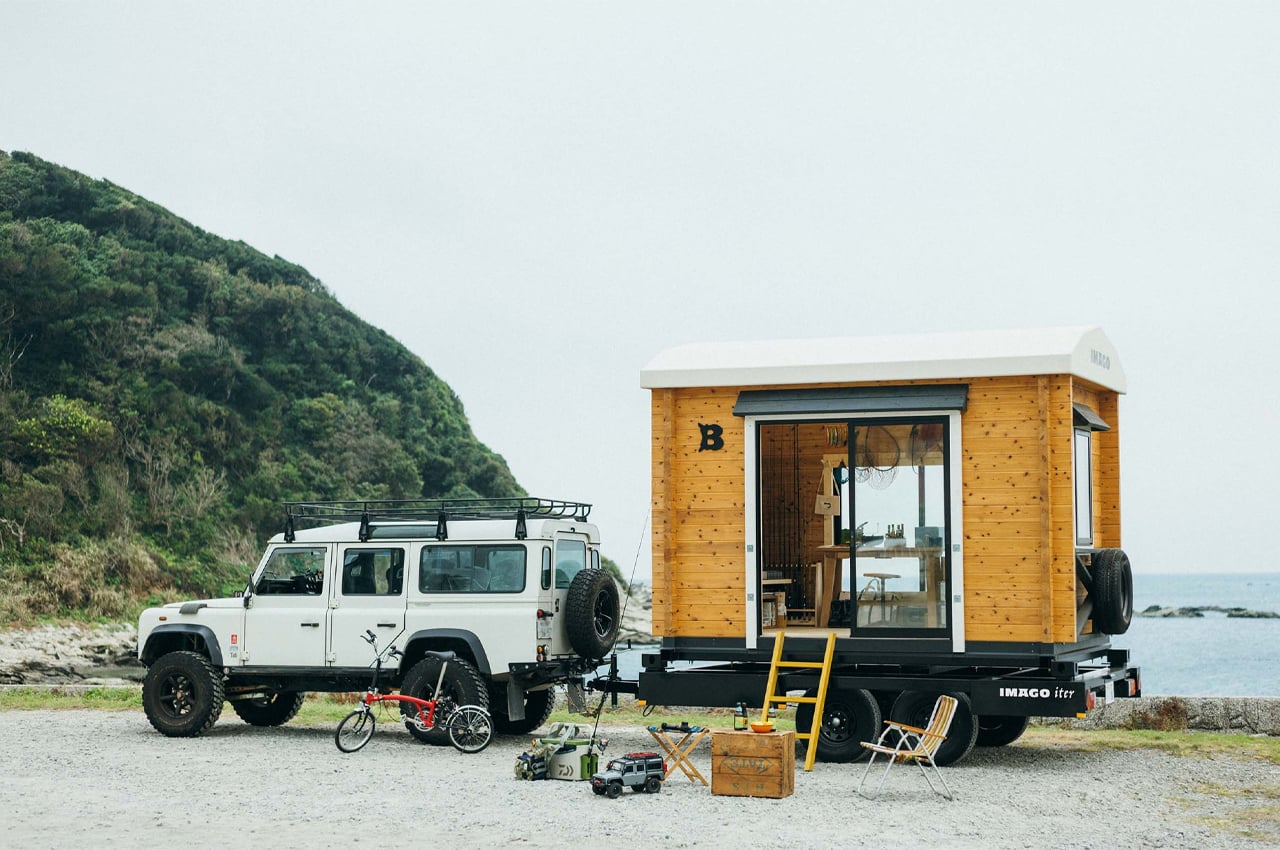
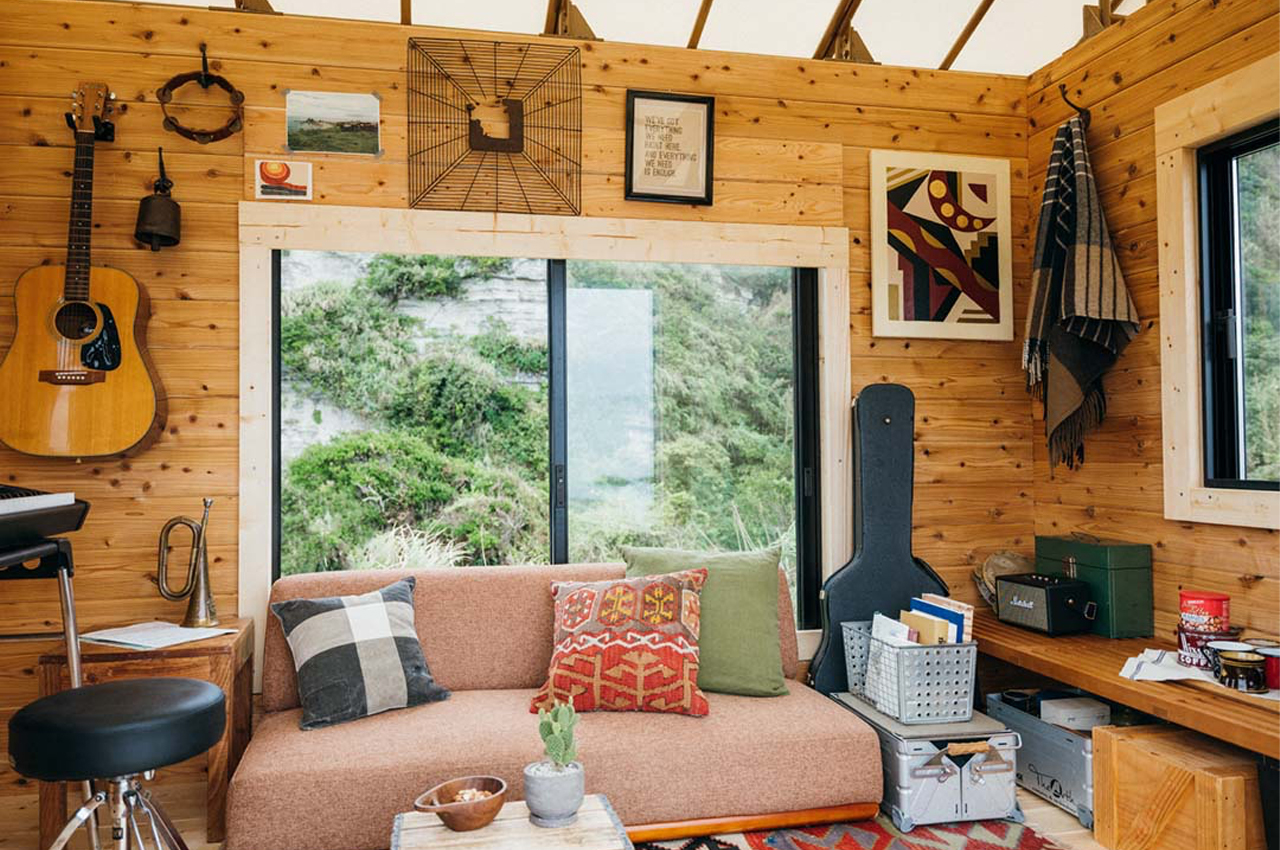
IMAGO-iter carries a 6.5m2 interior volume with 2.4 meters’ worth of headspace, providing just enough room for buyers to customize the space according to their needs. BESS took a customizable approach in designing every aspect of IMAGO-iter, so the mobile home is outfitted with only the bare essentials.
Why is it noteworthy?
Whether you use them as off-grid workspaces or campers on the go, mobile homes provide cozy getaways that we can bring wherever the wind takes us. BESS, a Japanese building firm that specializes in wooden houses, designed and constructed a mobile home called IMAGO-iter to join the party and move with our changing needs.
What we like
- You can choose between a traditional timber or a domed, wagon-like plastic membrane roof
- Suspension and electromagnetic brakes have also been worked into IMAGO-iter’s build to help ensure stable and safe driving
What we dislike
- Outfitted with only the bare essentials
10. Portable Cabin
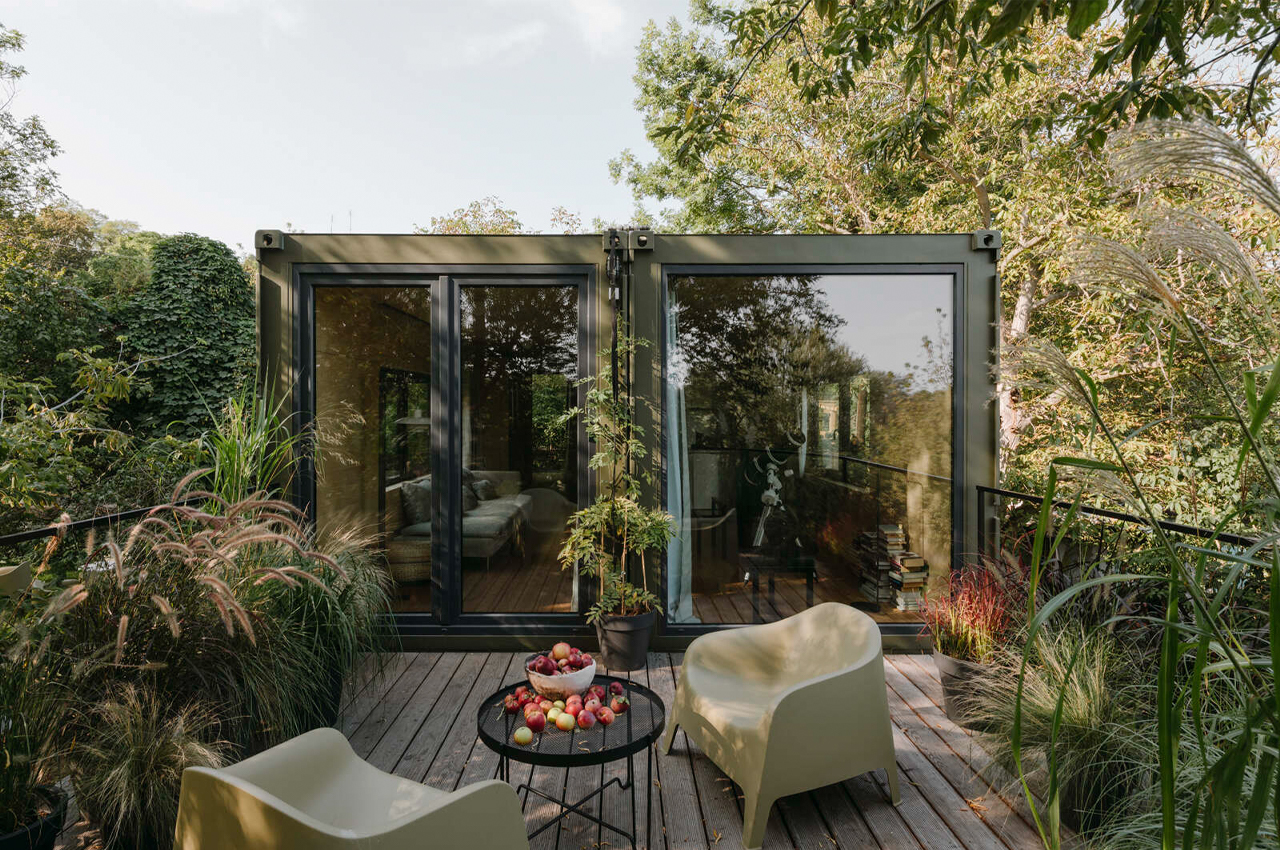
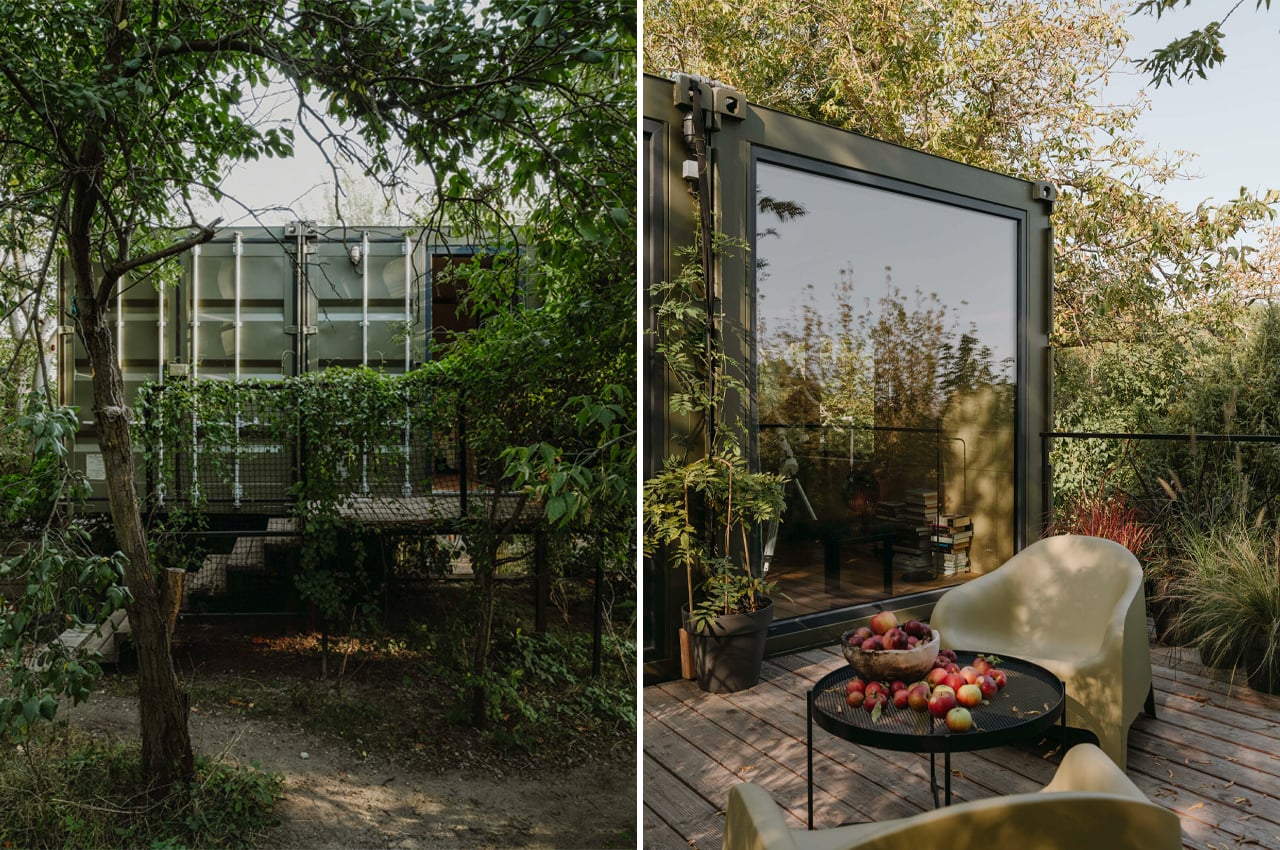
Designed as a prefabricated tiny home comprised of two disused freight containers, Portable Cabin is a 55m2 mobile home and office located in Poznan, Poland. Situated above a small creek, Wiercinski Studio’s Portable Cabin was prefabricated offsite before landing in the lush gardens of Poznan’s Szelagowski Park.
Why is it noteworthy?
The Portable Cabin from Wiercinski Studio is a mobile tiny home comprised of two disused shipping containers. When it comes to transforming shipping containers into homes, you get the best of both worlds. On one hand, you have yourself a homey, tiny cabin that can cozy into any small corner of the world like it’s been there all along. On the other hand, most architects accommodate a mobile lifestyle when designing shipping container homes, outfitting the piece of cargotecture with wheels and a trailer.
What we like
- The living spaces of the Portable Cabin are framed by birch plywood panels
- Features discreet army green facades made from trapezoidal sheet metal
What we dislike
No complaints!





